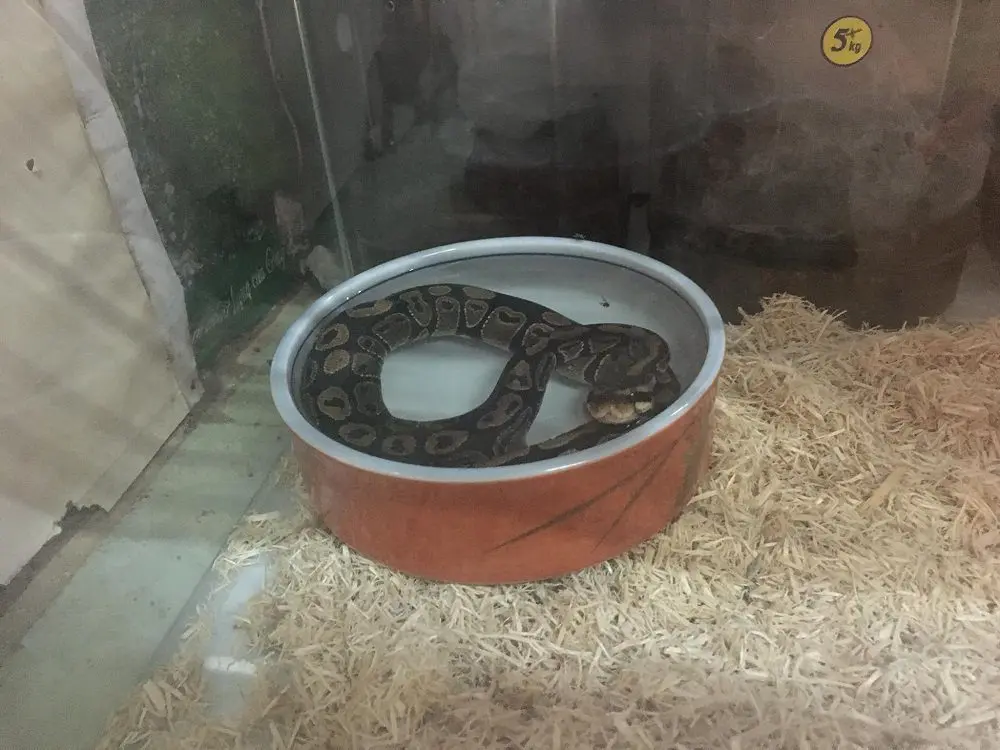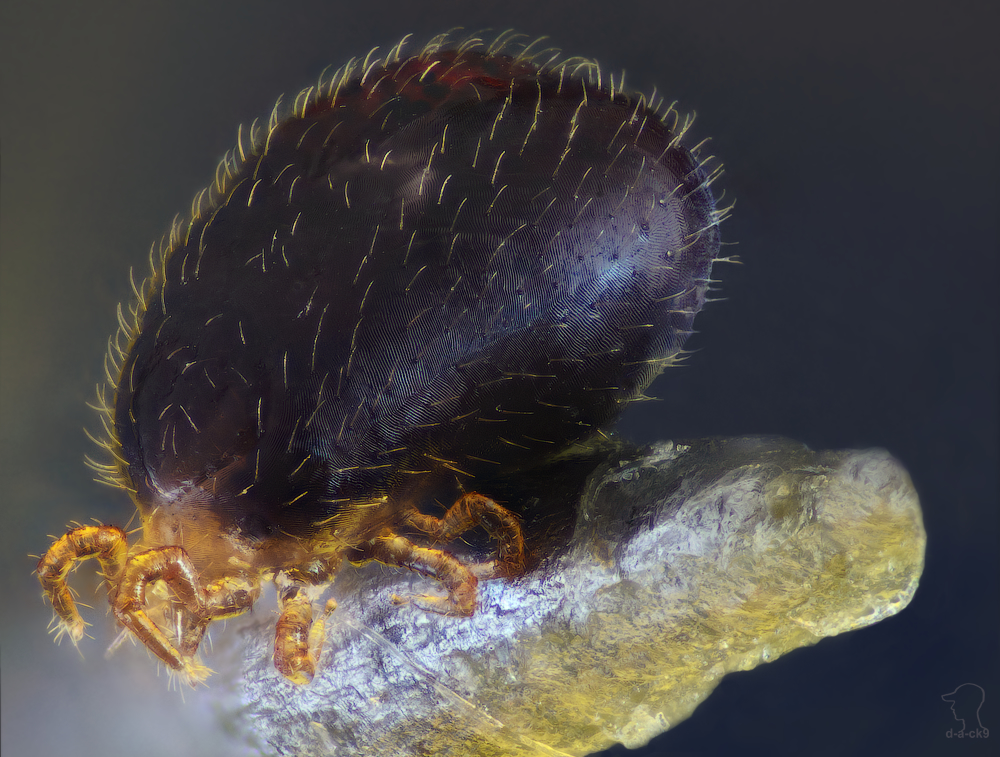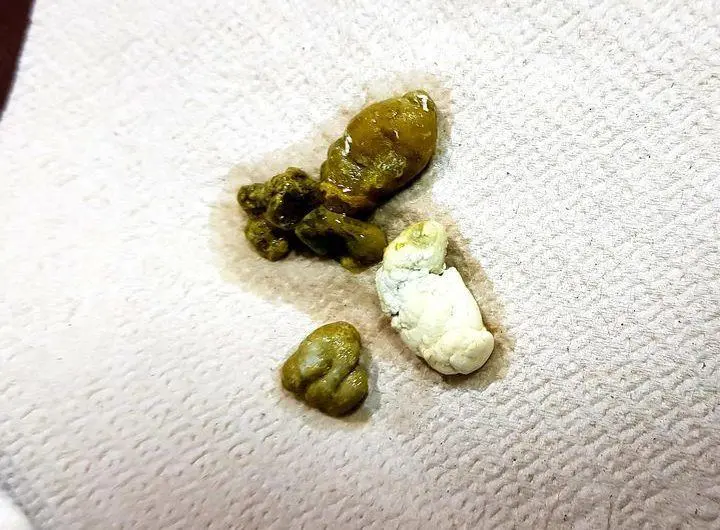Why ball python owners need a good understanding about mites is because they can multiply at such a rapid rate, spreading to other reptilian pets you may own.
A single female mite can have thousands of babies, they will all suck the blood of your python until the blood is poisoned. Mites in ball pythons can be fatal, resulting in anemia or septicemia.
Mites cause pain and discomfort in your pet, along with carrying a host of diseases, including IBD (Inclusion Body Disease). They create complications which include mouth rot, pneumonia, and more.
Before identifying the symptoms, causes, treatments, and prevention of mites in ball pythons, you want some understanding of the mite’s life cycle, which comprises of five stages:
|
Stage | Period |
|---|---|
| Egg stage | 28 to 98 hours |
| Larva stage | 18 to 47 days(non-feeding stage) |
| Protonymph stage | 3 to 14 days(feeding stage) |
| Deutonymph stage | 13 to 26 days(non-feeding stage) |
| Adult | 10 to 32 days(feeding and mating stage) |
Symptoms

Soaking in the water is a sign of mites.
If you are concerned that your ball python may have mites, there are a number of symptoms you can watch out for, these include:
- Restlessness
- Your pet is twitching its head
- Spending a lot of time soaking in the water bowl
- Digging
- Heaving its head from side to side
- Small red or black dots on the skin, especially around the mouth, nose, eyes, and under the chin
- Red or black dots floating in your pet’s water bowl
- Swelling around the eyes
- Abnormal or raised scales
- Incomplete shed
- Not able to shed
- Red or black dots on your hands and body when cleaning the enclosure or handling your ball python.
Causes

Ophionyssus natricis
Before looking closely at what the cause is that your ball python has mites, you need to be aware that there are three different types of mites you could be dealing with, these include:
- Ophionyssus Natricis – black or red dots or specks
- Ophionyssus Acertinus – orange or red specks
- Trombiculidae mites – red specks known as berry bugs
There are three main causes of mites in ball pythons. Knowing the causes can help you make the necessary adjustments to provide adequate treatment for your pet and put preventative measures in place.
Poor Hygiene
It is imperative that you keep your ball python’s enclosure clean and hygienic at all times. A pet python that is living in a dirty habitat will have an increased risk of mites.
Ensure you keep the enclosure clean with daily spot cleaning and monthly deep cleaning, remove any debris and dirt and provide fresh water daily.
You Recently Introduced a New Reptile
If you have recently adopted another reptile, mites can be passed from one to the other. It’s not uncommon for mites to be transferred between reptilian pets.
When it comes to enclosure cleaning or handling, you can transfer the mites, which is why you must always wash your hands thoroughly after handling your ball python and other pets to reduce the risk of this happening.
Wild Caught Ball Python
Wild-caught ball pythons have a much higher risk of mites than your captive pets. If you have a baby ball python with mites, it is possible your pet is wild-caught.
If your enclosure is clean and you haven’t introduced a new pet, then your pet may be wild-caught.
Treatment
In order to eradicate mites, you need to treat your ball python and its enclosure. You will also want to clean around the enclosure.
If you allow your pet to roam free from time to time, then you are going to have to clean all the areas your pet is allowed to roam.
Betadine Bath
A Betadine bath is an effective way to remove mites from your pet. Dilute Betadine in warm water until you get a light brown color. Allow your snake to soak in the water for around half an hour.
When you remove your pet, check it thoroughly for any mites that could be left behind.
You may need to give a Betadine bath once a day for a few days, ensuring there are not mites left on the python.
Nix

Mix Nix Ultra 2-in-1 with water and put the solution into a spray bottle. Spray on a paper towel or cloth and wipe it all over the ball python body except its eyes. Focus on its belly and neck areas.
Try to do this for a few days to ensure you’ve removed all mites and their eggs.
Reptile Mite Spray

Natural Chemistry Reptile Mite Spray is another good product to treat mites. It kills mites and lice effectively without harming the ball python.
You can spray directly on the snake (avoid the eyes) and then use a clean cloth to wipe.
Veterinary Treatment
If the above methods doesn’t do the trick, then you will want to seek veterinary treatment, especially if your pet is showing signs of severe problems caused by the mites, such as unable to complete its shed, or unable to shed at all.
Vets use a number of insecticides which are safe for your pet but should only be administered by the vet. These sprays are effective at eradicating mites.
They may also use a powder, which is used before your pet has been sprayed.
Your python is placed in a container that contains a layer of powder at the bottom for a few hours. After which your pet is rinsed in insecticide spray and held on a quarantine area.
Enclosure
Treating your ball python directly is one thing, but you also have to treat the enclosure and surrounding areas.
The enclosure should be stripped and everything washed, disinfected, and rinsed, then allow to air dry. This includes the water bowl, any decorations and substrate should be removed and replaced.
Treat Other Pets
If you have other reptilian pets, maybe another ball python, then you will want to keep a close eye on them to ensure that the mites have not been transferred.
Do a thorough clean of their enclosure and keep their habitat far from the infected habitat to reduce the risk of transference.
Prevention
Prevention is always better than cure, which can ensure you don’t have to deal with mite infestations any time soon.
Quarantine
Any new reptile you bring into your home should be placed in quarantine for up to three months.
Keep them in a separate room if possible, reducing the risk of transferring mites. If you have to keep them in the same room, try and keep the enclosure a distance from each other.
It’s best to assume every new reptile introduced into the home has mites to reduce the risk of an infestation.
Hand Washing

Wash your hand before and after handling
Always wash your hands thoroughly when you have been handling your ball python or any other reptiles in the home.
Don’t handle one pet and then another without washing your hands, mites will stay on your skin and transfer to the next pet.
Always wash your hands before and after handling your ball python.
Enclosure
Ensure your ball pythons enclosure is kept clean, to reduce the risk of mites.
Do a daily spot check, removing any debris, leftover foods, pee and poop. Always provide fresh, clean drinking water daily. Check the water for red or black spots when cleaning.

Ball python poop
Once a month you want to do a thorough deep clean of the enclosure, which means moving your pet to a temporary container while you wash and disinfect the tank, any accessories, water bowls and replace the substrate.
Summary
Mites can be fatal if you don’t know what you are looking for. Always check your ball pythons face and under its chin when handling to see if there are any red or black dots.
The good news is that with quarantine, hand washing, and a clean enclosure you can help reduce the risk of your pet having to experience a mite infestation.